Charging Technology Speed Performance Benchmarking
Chargers and Power Banks
Headphone & Speakers
Cases & Covers
Virtual Reality
Cables & Adapters
Media Player
Laptop
Tablet
Desktop
Cell Phone
Printers & Copiers
Memory Cards
TV
Computer Display
Game Console
Smart Home
Wearable Technology
Photo & Video Camera
Car Electronics
Car
Networking Equipment
Smart Toys
Home Audio & Video
Professional & Industrial
Storage Drive
Docking Station
Game Console Controllers
Set-top box
Keyboard, Mice, & Stylus
Portable Music Player
Computer Parts & Components
Cordless & Speakerphones
Projector
Software
Reporting
PowerPort I PD with 1 PD and 4 PIQ
by Anker






Interested in this product?
The Anker PowerPort I PD with 1 PD and 4 PIQ Charger is a Convenient Way to Get Multi Charging Up to 30W

The Anker PowerPort I PD with 1 PD and 4 PIQ is a seemingly newer model of the Anker PowerPort+ 5 USB-C with USB Power Delivery given the vast similarities shared by both these AC chargers. Both chargers offer a single USB Power Delivery based Type-C port and four downstream USB Type-A ports supporting Anker's own branded PowerIQ technology. Additionally these chargers also support the same USB Power Delivery 2.0 profiles of 15 watts (5 volts @ 3 amps), 27 watts (9 volts @ 3 amps), 30 watts (15 volts @ 2 amps) and 30 watts (20 volts @ 1.5 amps), allowing you to charge most phones in the market such as the Apple iPhone XS Max or Android phones such as Google's Pixel 3 XL and the Samsung Galaxy S9+ or even tablets and smaller notebook computers like Apple's 11-inch iPad Pro (2018) and MacBook (Early 2016).
For each of its downstream USB Type-A ports, the Anker PowerPort I PD with 1 PD and 4 PIQ charger provides up to 2.4 amps on an aggregate basis which brings a total of 30W for charging four devices simultaneously, which is also similar to the Anker PowerPort+ 5 USB-C with USB Power Delivery charger.
Note if not needing to charge that many devices at a time, there's also a dual-port Anker PowerPort II with Power Delivery charger option which is a less premium version of the Anker PowerPort I PD with 1 PD and 4 PIQ, also supporting both USB Power Delivery and Anker's proprietary PowerIQ fast charging technology.
Here's a quick close-up of how the Anker PowerPort I PD with 1 PD and 4 PIQ charger looks like from its packaging.

Note the Anker PowerPort I PD with 1 PD and 4 PIQ charger does not support Qualcomm Quick Charge as well as the Xiaomi Mi Notebook Air 13.3".
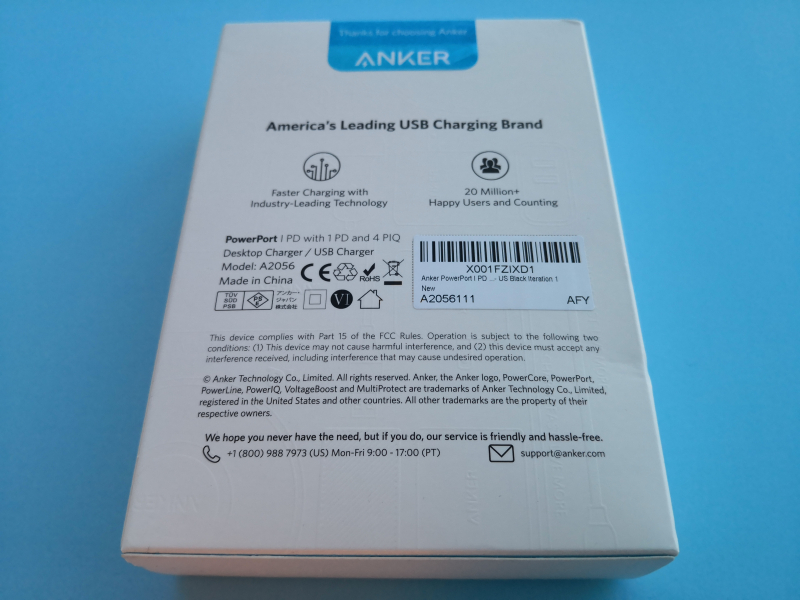
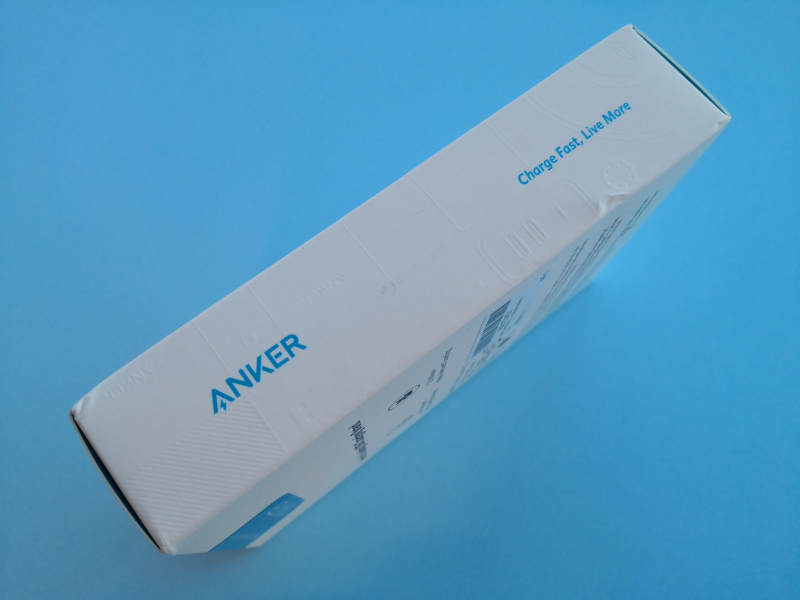
Most Anker chargers come in luxury looking boxes given their premium price such as this one.

Like the Anker PowerPort+ 5 USB-C with USB Power Delivery, the Anker PowerPort I PD with 1 PD and 4 PIQ charger is also bundled together with a ac power cord and charger installation adhesive strip.

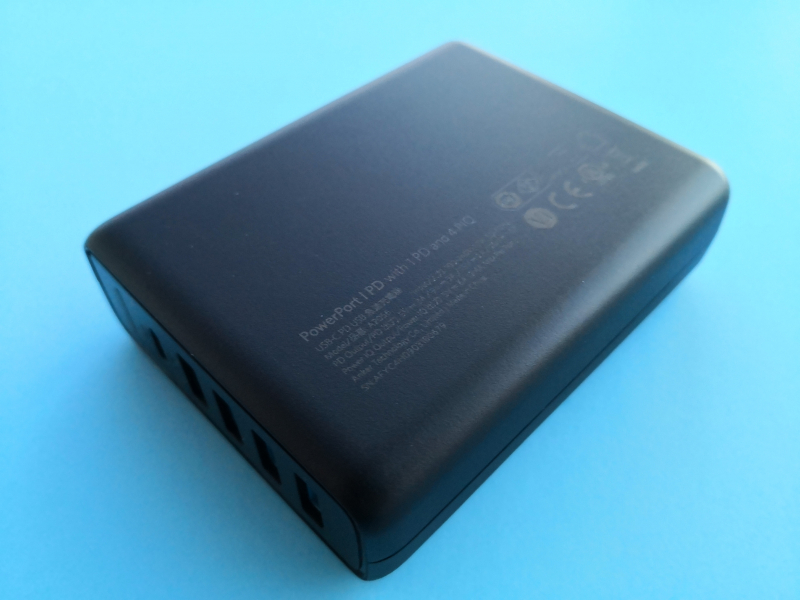
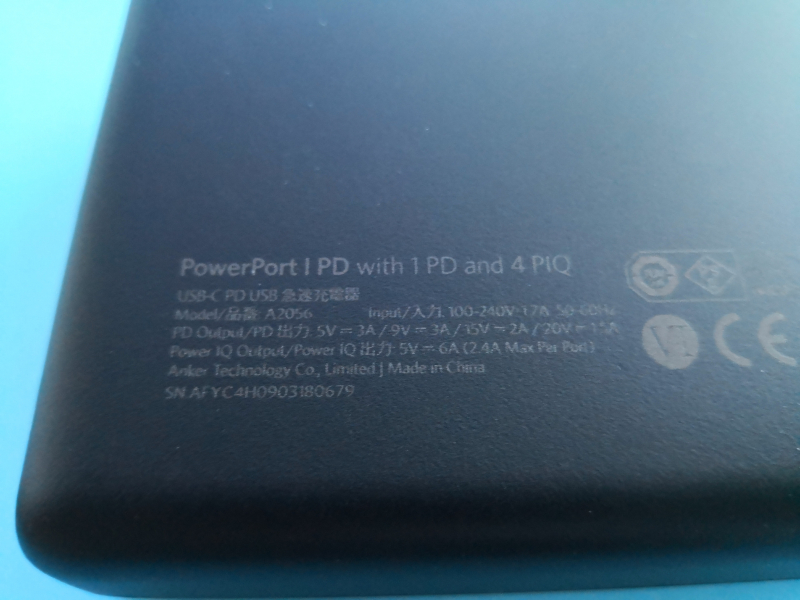
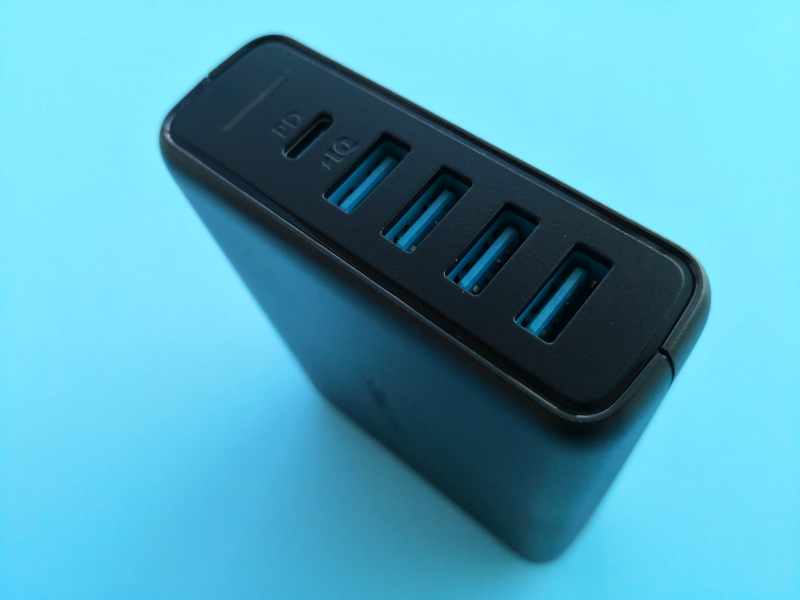
The charger gets own power supply by plugging in the ac power cord accessory to a ac wall socket. The LED indicator above the charger's USB ports should light up once connected to ac power.
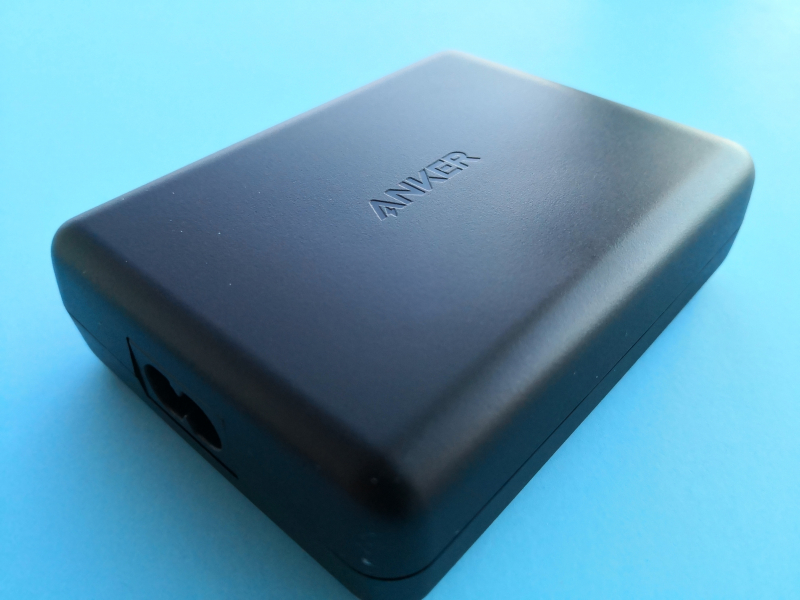
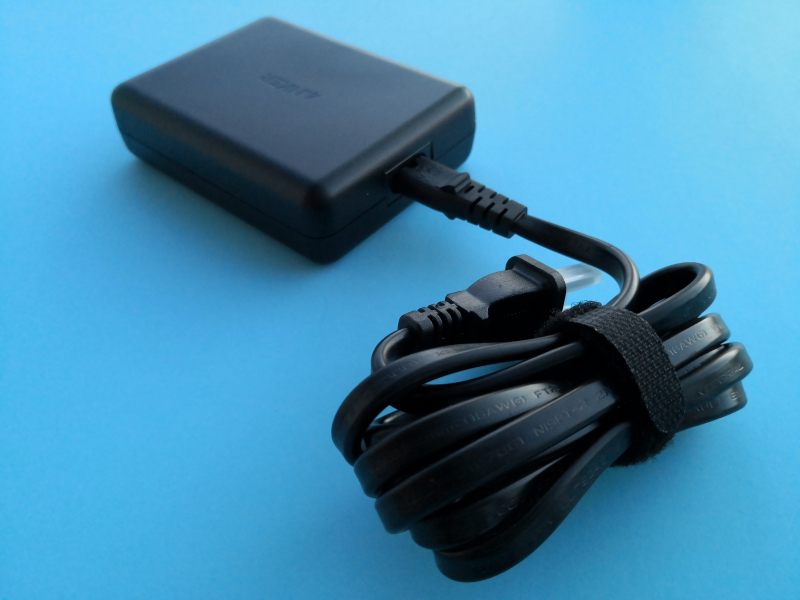
To see how the Anker PowerPort I PD with 1 PD and 4 PIQ charger supports power, we used the USB Power Test App from Granite River Labs with the Granite River Labs USB Power Delivery Compliance C2 Tester to produce the following test results.
The USB Power Test App first negotiates a power contract for every PDO supported by the Anker charger, and increases the load gradually to find the threshold where over current protection (OCP) kicks in and voltage and current start to drop for safety reasons.
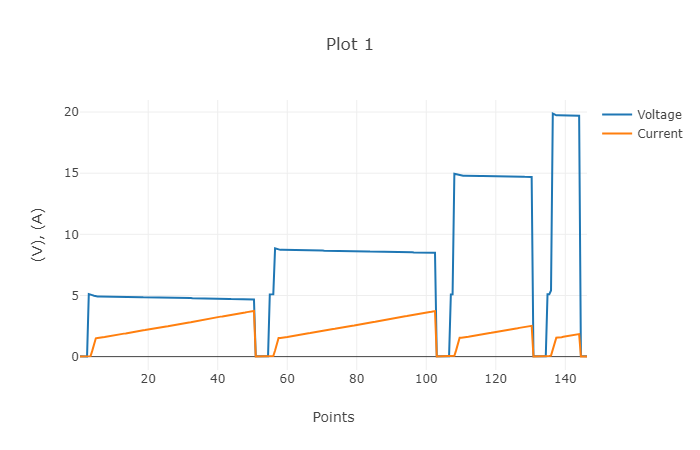
The USB Power Test App reports out all the PDO's supported by the Anker charger and their OCP thresholds.
| PDO | VAC | OCP (A) | %OCP | OCP Timeout (sec) | Voltage Drop(V) |
|---|---|---|---|---|---|
| PDO#1 Fixed: 5V 3A | 3.73 | 124.5% | 0.4 | 0.39 | |
| PDO#2 Fixed: 9V 3A | 3.72 | 124% | 0.4 | 0.41 | |
| PDO#3 Fixed: 15V 2A | 2.52 | 126% | 0.4 | 0.29 | |
| PDO#4 Fixed: 20V 1.5A | 1.84 | 122.6% | 0.4 | 0.23 |
The USB Power Test App from Granite River Labs takes this data to produce an I-V curve which graphically shows the relationship between voltage and current for each PDO. We can observe as the current increases beyond the OCP threshold, the voltage immediately shuts off.
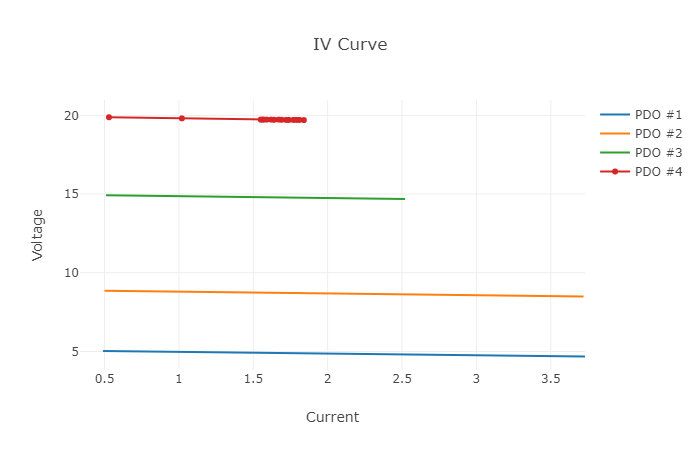
The USB Power Test App can also use the Granite River Labs USB Power Delivery Compliance C2 Tester integrated with the GW Instek APS-7100 programmable AC power supply to compare the charger's power output vs power input so that power efficiency can be measured and compared to regulatory limits from United States of Energy (DOE) Level VI or European Union's CoC Tier 2 requirements. We can repeat the power efficiency tests for different PDO's, current load conditions, and different AC input ranges, allowing us to get a complete picture of power efficiency ranges across all different usage scenarios.
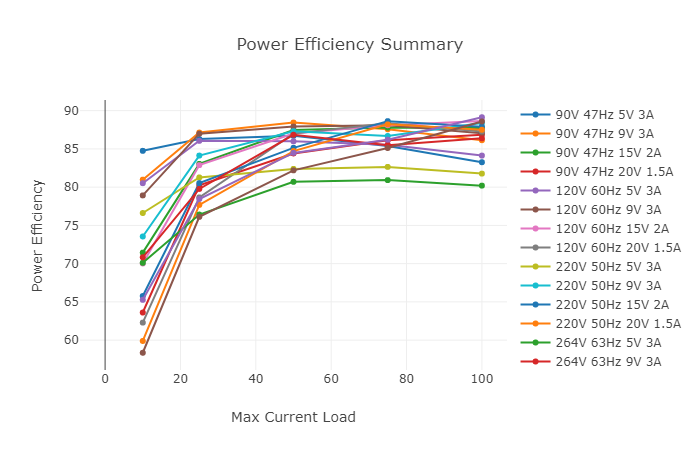
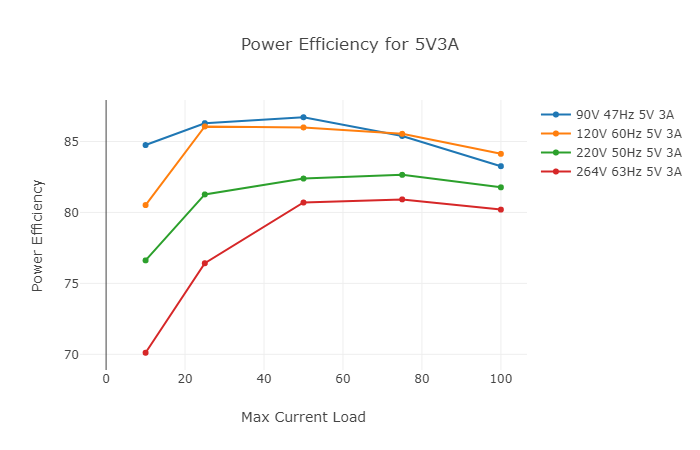
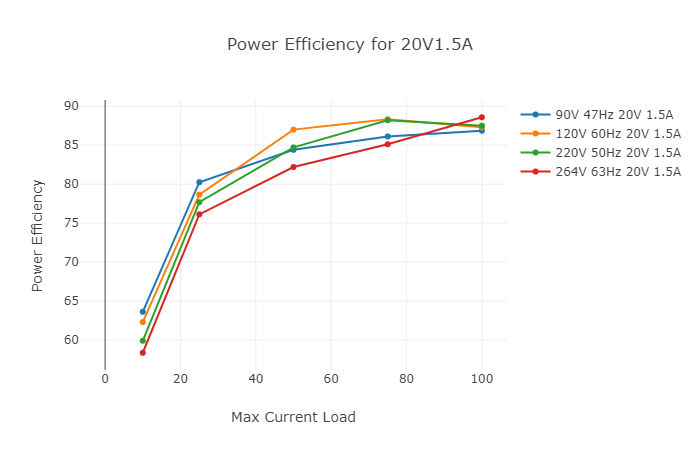
Using the USB Power Delivery Compliance C2 Tester from Granite River Labs to run just a subset of the full USB Power Delivery compliance test suite, a compliance failure was observed for the Anker PowerPort I PD with 1 PD and 4 PIQ charger.
USB-IF High Level Mapping Summary
Sl No
|
Test Category
|
Test Group Description
|
Test Result
|
|---|---|---|---|
1
|
PHY_PRIMARY_TX
|
BMC Physical Layer Transmitter
|
PASS
|
2
|
PHY_PRIMARY_RX
|
BMC Physical Layer Receiver
|
PASS
|
3
|
PHY_PRIMARY_MISC
|
BMC Physical Layer Miscellaneous
|
PASS
|
4
|
PROT_PRIMARY
|
Protocol Specific Primary
|
FAIL
|
5
|
POWER_PRIMARY
|
Power Source/Sink Primary
|
PASS
|
Result Summary
Sl No
|
Test ID
|
Test Name
|
Test Result
|
|---|---|---|---|
1
|
TDA.2.1.1.1
|
TDA.2.1.1.1 BMC PHY TX EYE
|
PASS
|
2
|
TDA.2.1.1.2
|
TDA.2.1.1.2 BMC PHY TX BIT
|
PASS
|
3
|
TDA.2.1.2.2
|
TDA.2.1.2.2 BMC PHY RX INT REJ
|
PASS
|
4
|
TDA.2.1.2.1
|
TDA.2.1.2.1 BMC PHY RX BUSIDL
|
PASS
|
5
|
TDA.2.1.3.1
|
TDA.2.1.3.1 BMC PHY TERM
|
PASS
|
7
|
TDA.2.2.1
|
TDA.2.2.1 BMC PROT SEQ GETCAPS
|
PASS
|
8
|
TDA.2.2.2.1
|
TDA.2.2.2.1 BMC PROT SEQ CHKCAP P PC
|
FAIL
|
9
|
TDA.2.2.2.2
|
TDA.2.2.2.2 BMC PROT SEQ CHKCAP NOMARK P PC
|
PASS
|
13
|
TDA.2.2.7
|
TDA.2.2.7 BMC PROT BIST NOT 5V SRC
|
PASS
|
15
|
TDA.2.2.9
|
TDA.2.2.9 BMC PROT GSC REC
|
PASS
|
16
|
TDA.2.3.1.1
|
TDA.2.3.1.1 POW SRC LOAD P PC
|
PASS
|
17
|
TDA.2.3.2.1
|
TDA.2.3.2.1 POW SRC TRANS P PC
|
PASS
|
BMC Eye Diagram
We'll find out how the Anker PowerPort I PD with 1 PD and 4 PIQ charger works with various USB Type-C devices in upcoming reviews.
View Full Article
USB PD Charging Technologies & Battery Life Benchmarking
Featured Products
 GTrusted
GTrusted


































